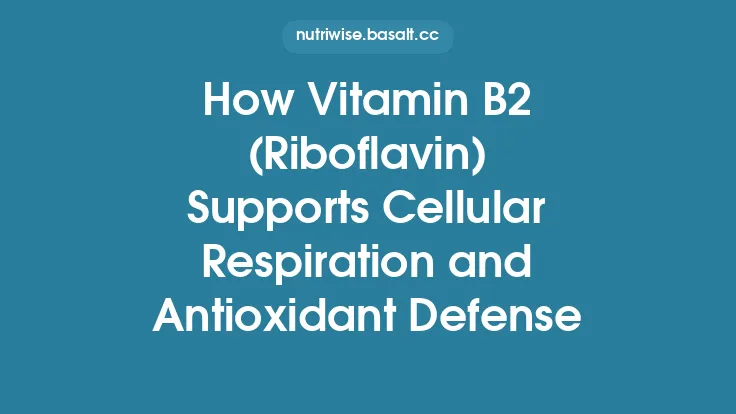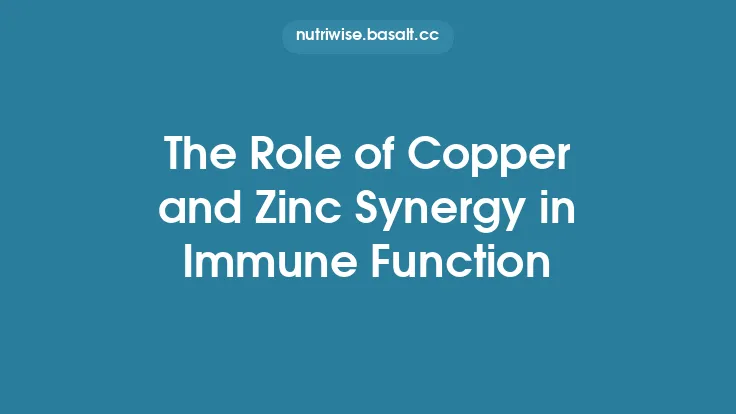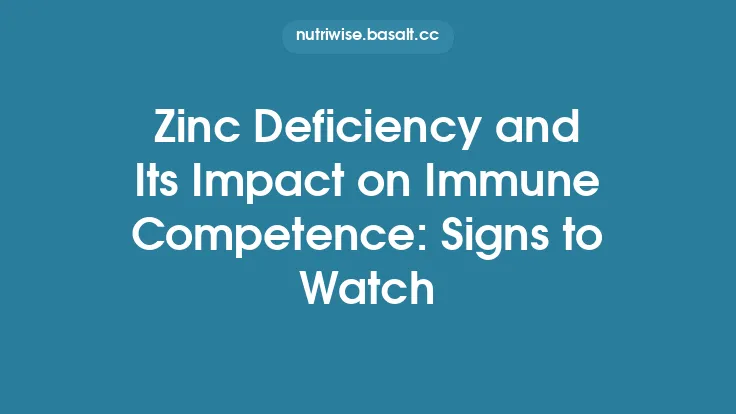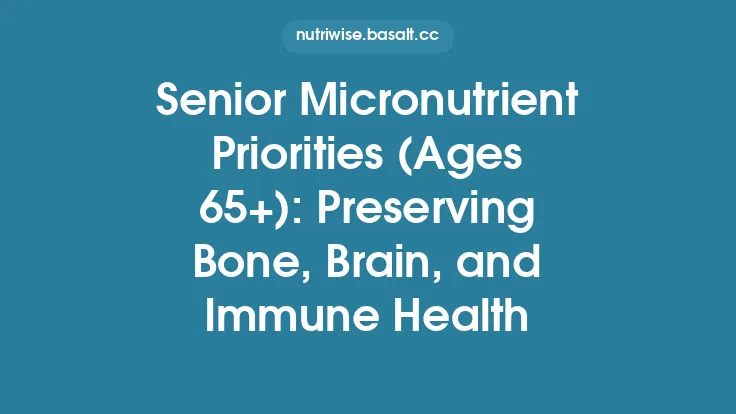Zinc is a trace element that occupies a central position in the immune system’s architecture, acting as a structural and catalytic cofactor for a multitude of proteins that govern the behavior of white blood cells. Its influence extends from the earliest stages of leukocyte development in the bone marrow to the execution of precise antiviral actions during an infection. Understanding how zinc orchestrates these processes provides insight into why maintaining optimal intracellular zinc pools is essential for a robust, virus‑resistant immune response.
Zinc Homeostasis and Cellular Availability
The functional impact of zinc on leukocytes hinges on tightly regulated intracellular concentrations. Two families of membrane transporters—ZIP (Zrt‑ and Irt‑like Protein) importers and ZnT (Zinc Transporter) exporters—control the flux of zinc across the plasma membrane and between intracellular compartments.
- ZIP transporters (e.g., ZIP1, ZIP4, ZIP8) increase cytosolic zinc by importing extracellular zinc or releasing it from organelles such as the endoplasmic reticulum and lysosomes.
- ZnT transporters (e.g., ZnT1, ZnT5, ZnT7) lower cytosolic zinc by sequestering it into vesicles or exporting it out of the cell.
In resting leukocytes, basal zinc levels are maintained at nanomolar concentrations, sufficient to stabilize zinc‑finger transcription factors while preventing toxic overload. Upon activation—such as exposure to pathogen‑associated molecular patterns (PAMPs)—signaling cascades trigger rapid redistribution of zinc. For instance, Toll‑like receptor (TLR) engagement in macrophages induces ZIP8 expression, leading to a transient rise in cytosolic zinc that modulates downstream NF‑κB activity.
Metallothioneins (MTs), cysteine‑rich proteins with high zinc‑binding capacity, act as intracellular buffers. They release zinc in response to oxidative cues or cytokine signaling, thereby providing a rapid source of free zinc precisely when immune cells need it most.
Impact of Zinc on Neutrophil Function
Neutrophils constitute the first line of cellular defense, executing phagocytosis, degranulation, and the generation of neutrophil extracellular traps (NETs). Zinc influences each of these effector mechanisms:
- Chemotaxis – Zinc modulates the activity of the small GTPases Rac1 and Cdc42, which orchestrate actin polymerization required for directed migration toward chemokine gradients. Experimental depletion of intracellular zinc impairs chemotactic speed and accuracy.
- Phagocytosis and Oxidative Burst – The NADPH oxidase complex, responsible for producing reactive oxygen species (ROS) that kill engulfed microbes, contains zinc‑binding subunits (e.g., p22^phox). Adequate zinc ensures proper assembly and electron transfer efficiency.
- NET Formation – Zinc regulates the activity of peptidyl‑arginine deiminase 4 (PAD4), an enzyme that citrullinates histones to facilitate chromatin decondensation during NETosis. Controlled zinc levels promote effective NET release without excessive tissue damage.
Collectively, these zinc‑dependent processes enable neutrophils to rapidly locate, ingest, and neutralize viral particles or infected cells.
Zinc and Monocyte/Macrophage Antiviral Activities
Monocytes differentiate into macrophages and dendritic cells, which are pivotal for antigen presentation and cytokine production. Zinc shapes their antiviral repertoire through several mechanisms:
- Pattern‑Recognition Receptor (PRR) Signaling – Zinc interferes with the dimerization of TLR4 and the subsequent recruitment of MyD88, fine‑tuning the magnitude of pro‑inflammatory cytokine release (e.g., IL‑6, TNF‑α). This modulation prevents hyper‑inflammation while preserving antiviral signaling.
- Interferon Production – Cytosolic zinc enhances the activity of interferon regulatory factor 3 (IRF3) by stabilizing its DNA‑binding domain. Elevated IRF3 activity boosts type I interferon (IFN‑α/β) transcription, a cornerstone of the antiviral state.
- Phagolysosomal Fusion – Zinc is required for the proper function of the vacuolar ATPase (V‑ATPase) that acidifies phagolysosomes. Acidic conditions activate lysosomal enzymes that degrade viral particles internalized by macrophages.
- Autophagy Regulation – Autophagic clearance of viral components is zinc‑dependent; the ATG4B cysteine protease, essential for autophagosome maturation, contains a zinc‑binding motif that influences its catalytic efficiency.
Through these pathways, zinc equips monocytes and macrophages with a balanced cytokine profile, efficient viral clearance, and the capacity to present antigens to adaptive immune cells.
Modulation of Natural Killer Cell Cytotoxicity by Zinc
Natural Killer (NK) cells patrol the body for virally infected or transformed cells, executing cytotoxicity via perforin/granzyme release and death‑receptor engagement. Zinc contributes to NK cell competence in several ways:
- Receptor Expression – The activating receptor NKG2D, which recognizes stress‑induced ligands on infected cells, contains a zinc‑finger domain essential for ligand binding. Zinc deficiency diminishes NKG2D surface expression, reducing NK cell activation.
- Granule Exocytosis – The SNARE complex that mediates granule fusion with the plasma membrane includes the zinc‑binding protein synaptotagmin‑7. Adequate zinc ensures rapid granule release upon target recognition.
- Cytokine Production – NK cells secrete IFN‑γ, a cytokine that amplifies antiviral immunity. Zinc stabilizes the transcription factor T‑bet, which drives IFN‑γ gene transcription.
Thus, zinc sustains both the recognition and killing arms of NK cell function, reinforcing early antiviral defenses.
Zinc’s Role in Adaptive Immunity: T‑Cell Development and Function
While innate cells act swiftly, adaptive immunity provides specificity and memory. Zinc is indispensable throughout T‑cell ontogeny and effector phases:
- Thymic Selection – The thymus requires zinc for the activity of the transcription factor AIRE (Autoimmune Regulator), which promotes expression of peripheral tissue antigens necessary for negative selection. Proper zinc levels prevent the escape of autoreactive T cells, preserving immune tolerance during viral infections.
- Signal Transduction – The T‑cell receptor (TCR) complex initiates signaling cascades that rely on zinc‑dependent kinases such as Lck and ZAP‑70. Zinc binds to the SH2 domains of these kinases, stabilizing their interaction with phosphorylated ITAMs (Immunoreceptor Tyrosine-based Activation Motifs).
- Cytokine Production – CD4⁺ helper T cells differentiate into Th1, Th2, Th17, or regulatory subsets based on cytokine milieu. Zinc influences the balance by modulating STAT (Signal Transducer and Activator of Transcription) phosphorylation; for example, zinc promotes STAT1 activation, favoring Th1 responses that are critical for viral clearance.
- Cytotoxic T Lymphocyte (CTL) Function – CD8⁺ CTLs require zinc for the expression of perforin and granzyme B, both of which contain zinc‑binding motifs that are essential for their structural integrity and enzymatic activity.
- Memory Formation – Zinc regulates the expression of the transcription factor Bcl‑6, a master regulator of germinal‑center B‑cell and T‑follicular helper cell interactions that underpin long‑lasting antibody responses to viral antigens.
Through these mechanisms, zinc ensures that T cells develop correctly, become properly activated, and generate effective, virus‑specific effector and memory populations.
Molecular Mechanisms Underpinning Zinc’s Antiviral Effects
Beyond supporting immune cells, zinc can directly interfere with viral life cycles. Several molecular strategies have been identified:
- Inhibition of Viral Polymerases – Many RNA viruses (e.g., rhinovirus, coronavirus, influenza) rely on RNA‑dependent RNA polymerases (RdRps) that contain catalytic sites coordinated by divalent metal ions. Zinc can displace the native Mg²⁺/Mn²⁺ ions, leading to conformational distortion and loss of polymerase activity.
- Blocking Viral Protease Activity – Zinc ions bind to the catalytic cysteine or histidine residues of viral proteases (e.g., 3CL^pro of coronaviruses, NS3 protease of flaviviruses), rendering them inactive and preventing processing of viral polyproteins.
- Stabilization of Host Antiviral Proteins – Zinc‑finger antiviral protein (ZAP) recognizes CpG‑rich viral RNA and recruits the RNA exosome for degradation. Zinc is essential for the structural integrity of ZAP’s zinc‑finger domains, enabling efficient viral RNA targeting.
- Interference with Viral Entry – Certain viruses exploit host metalloproteinases for cell entry. Zinc chelation of these metalloproteinases can reduce viral fusion and internalization.
These direct antiviral actions complement the immune‑mediated clearance, creating a two‑pronged defense that is especially valuable during the early phases of infection.
Zinc‑Dependent Enzymes and Viral Replication Inhibition
A subset of host enzymes that require zinc as a cofactor play pivotal roles in limiting viral propagation:
- Superoxide Dismutase 1 (SOD1) – Although primarily known for antioxidant activity, SOD1 also modulates redox‑sensitive signaling pathways that affect viral gene expression. Zinc stabilizes the SOD1 dimer, preserving its function.
- Carbonic Anhydrase IX (CAIX) – Some viruses manipulate intracellular pH to favor replication. Zinc‑dependent CAIX helps maintain pH homeostasis, counteracting viral attempts to acidify the cytosol.
- Matrix Metalloproteinases (MMPs) – While MMPs can facilitate viral spread by degrading extracellular matrix, zinc‑mediated regulation of MMP activity (via tissue inhibitors of metalloproteinases, TIMPs) can limit tissue invasion and viral dissemination.
Understanding these enzyme‑centric pathways highlights how zinc’s catalytic roles intersect with antiviral defense beyond immune cell signaling.
Zinc Ionophores and Therapeutic Strategies
Because intracellular zinc concentrations are tightly controlled, therapeutic approaches sometimes employ zinc ionophores—small molecules that facilitate zinc entry into cells—to transiently boost cytosolic zinc during viral infections. Notable ionophores include:
- Pyrithione – Demonstrated in vitro to raise intracellular zinc to levels that inhibit the replication of several RNA viruses, including SARS‑CoV‑2.
- Quercetin – A flavonoid that can act as a mild zinc ionophore, enhancing zinc uptake in immune cells and contributing to antiviral activity.
- Hydroxychloroquine – Historically investigated for its ionophoric properties, though clinical outcomes have been mixed and safety considerations limit its use.
When combined with adequate extracellular zinc, ionophores can create a pharmacologically relevant surge in intracellular zinc, temporarily overwhelming viral replication machinery. However, the timing, dosage, and potential off‑target effects require careful optimization in clinical settings.
Clinical Evidence Linking Zinc Status to Viral Outcomes
Epidemiological and interventional studies have repeatedly associated zinc status with the course of viral illnesses:
- Common Cold (Rhinovirus) – Randomized trials have shown that individuals with higher baseline serum zinc experience reduced symptom severity and shorter illness duration when infected with rhinovirus.
- Influenza – Observational data indicate that low plasma zinc correlates with increased hospitalization rates and higher viral load in influenza‑A infection.
- COVID‑19 – Cohort analyses have reported that patients with serum zinc concentrations below the reference range are more likely to progress to severe disease, require intensive care, or experience prolonged viral shedding. Some interventional studies using zinc supplementation alongside standard care have demonstrated modest improvements in time to clinical recovery, though results are heterogeneous.
- Hepatitis C Virus (HCV) – In chronic HCV infection, zinc supplementation has been linked to improved liver enzyme profiles and enhanced interferon‑stimulated gene expression, suggesting a supportive role in antiviral therapy.
These findings reinforce the concept that maintaining sufficient intracellular zinc reserves is a measurable factor in the host’s ability to control viral replication and mitigate disease severity.
Considerations for Research and Future Directions
While the mechanistic links between zinc and antiviral immunity are increasingly clear, several knowledge gaps remain:
- Quantitative Thresholds for Cellular Zinc – Defining the precise intracellular zinc concentrations that optimize each leukocyte function without triggering cytotoxicity is essential for translating bench findings into therapeutic windows.
- Zinc Transporter Polymorphisms – Genetic variations in ZIP and ZnT transporters may influence individual responses to zinc‑based interventions. Large‑scale genomic studies could identify subpopulations that benefit most from targeted zinc modulation.
- Ionophore Safety Profiles – Systematic evaluation of ionophore pharmacokinetics, tissue distribution, and off‑target metal interactions will be required before widespread clinical adoption.
- Synergy with Emerging Antivirals – Investigating how zinc augmentation interacts with novel antiviral agents (e.g., protease inhibitors, monoclonal antibodies) could uncover additive or synergistic effects that enhance treatment efficacy.
- Long‑Term Impact on Immune Memory – Longitudinal studies assessing whether zinc status during acute infection influences the durability of vaccine‑induced or infection‑derived immunity will inform public‑health strategies.
Addressing these areas will refine our understanding of zinc as a modifiable factor in antiviral defense and may lead to precision‑nutrition or pharmacologic approaches that harness its full immunological potential.
In sum, zinc operates at multiple levels of the immune hierarchy: it fine‑tunes the migration, phagocytic capacity, and cytotoxicity of innate leukocytes; it shapes the development, signaling, and effector functions of adaptive T cells; and it directly impairs viral replication through enzymatic inhibition and structural disruption. By sustaining optimal intracellular zinc pools, the body equips its white blood cells with the biochemical tools necessary to detect, neutralize, and remember viral invaders, underscoring zinc’s indispensable role in antiviral immunity.





